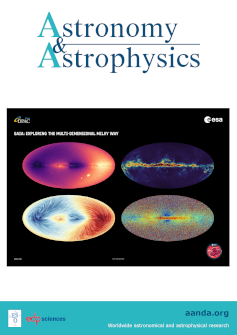嵌入费米子暗物质晕中的人马座恒星流
IF 5.8
2区 物理与天体物理
Q1 ASTRONOMY & ASTROPHYSICS
引用次数: 0
摘要
上下文。恒星流是银河系引力势的重要示踪剂,具有暗物质模型分布问题的关键含义,无论是在现象学ΛCDM晕内还是之外。在文献中第一次,基于(量子)统计力学和热力学等第一物理原理的暗物质(DM)晕模型被用来试图重现人马座(Sgr)流的6D观测。因此,我们的目标是提取定量和定性结论,说明我们的假设与观察结果的关系有多好。我们用中性费米子的球形自引力系统来模拟两个DM光晕,即Sgr矮星和它的宿主的光晕,该系统解释了粒子逃逸和费米子简并(由于泡利不相容原理)的影响,后者在光晕的中心产生了高密度的核心。还考虑了每个星系的全重子成分。我们使用了一种具有~ 105个粒子的喷雾算法来生成Sgr潮汐碎片,它在宿主-祖系统的联合引力势中演化,然后与流的完整相空间数据进行直接比较。我们对包括粒子质量在内的费米子模型的不同参数设置重复了这种模拟,特别注意测试了物理学允许的不同DM晕形态,包括多向密度尾和幂律趋势。我们发现所考虑的费米子晕模型只能再现人马座流的后臂。在观测允许的流移动的封闭质量范围内,费米子晕模型的幂律行为和多向性行为都不能解释观测到的领头尾的趋势——这一结论与先前使用其他类型球对称晕的分析一致。因此,我们得出结论,需要进一步改进模型,例如放弃球面对称并包括大麦哲伦云的扰动,以便在这种第一性原理晕模型中正确地建模整个银河系的潜力。本文章由计算机程序翻译,如有差异,请以英文原文为准。
The Sagittarius stellar stream embedded in a fermionic dark matter halo
Context. Stellar streams are essential tracers of the gravitational potential of the Milky Way, with key implications for the problem of dark matter model distributions, either within or beyond phenomenological ΛCDM halos.Aims. For the first time in the literature, a dark matter (DM) halo model based on first physical principles such as (quantum) statistical mechanics and thermodynamics is used to try to reproduce the 6D observations of the Sagittarius (Sgr) stream. Thus, we aim to extract quantitative and qualitative conclusions on how well our assumptions stand with respect to the observations. We model both DM halos, the one of the Sgr dwarf and the one of its host, with a spherical self-gravitating system of neutral fermions that accounts for the effects of particle escape and fermion degeneracy (due to the Pauli exclusion principle), the latter causing a high-density core at the center of the halo. Full baryonic components for each galaxy are also considered.Methods. We used a spray algorithm with ∼ 105 particles to generate the Sgr tidal debris, which evolves in the combined gravitational potential of the host-progenitor system, to then make a direct comparison with the full phase-space data of the stream. We repeated this kind of simulation for different parameter setups of the fermionic model including the particle mass, with special attention to testing different DM halo morphologies allowed by the physics, including polytropic density tails as well as power-law-like trends.Results. We find that the fermionic halo models considered can only reproduce the trailing arm of the Sgr stream. Within the observationally allowed span of enclosed masses where the stream moves, neither the power-law-like nor the polytropic behavior of the fermionic halo models can answer for the observed trend of the leading tail – a conclusion that is shared by former analyses using other types of spherically symmetric halos. Thus, we conclude that further model improvements, such as abandoning spherical symmetry and including the Large Magellanic Cloud perturber, are needed for the proper modeling of the overall Milky Way potential within this kind of first-principle halo model.
求助全文
通过发布文献求助,成功后即可免费获取论文全文。
去求助
来源期刊

Astronomy & Astrophysics
地学天文-天文与天体物理
CiteScore
10.20
自引率
27.70%
发文量
2105
审稿时长
1-2 weeks
期刊介绍:
Astronomy & Astrophysics is an international Journal that publishes papers on all aspects of astronomy and astrophysics (theoretical, observational, and instrumental) independently of the techniques used to obtain the results.
 求助内容:
求助内容: 应助结果提醒方式:
应助结果提醒方式:


